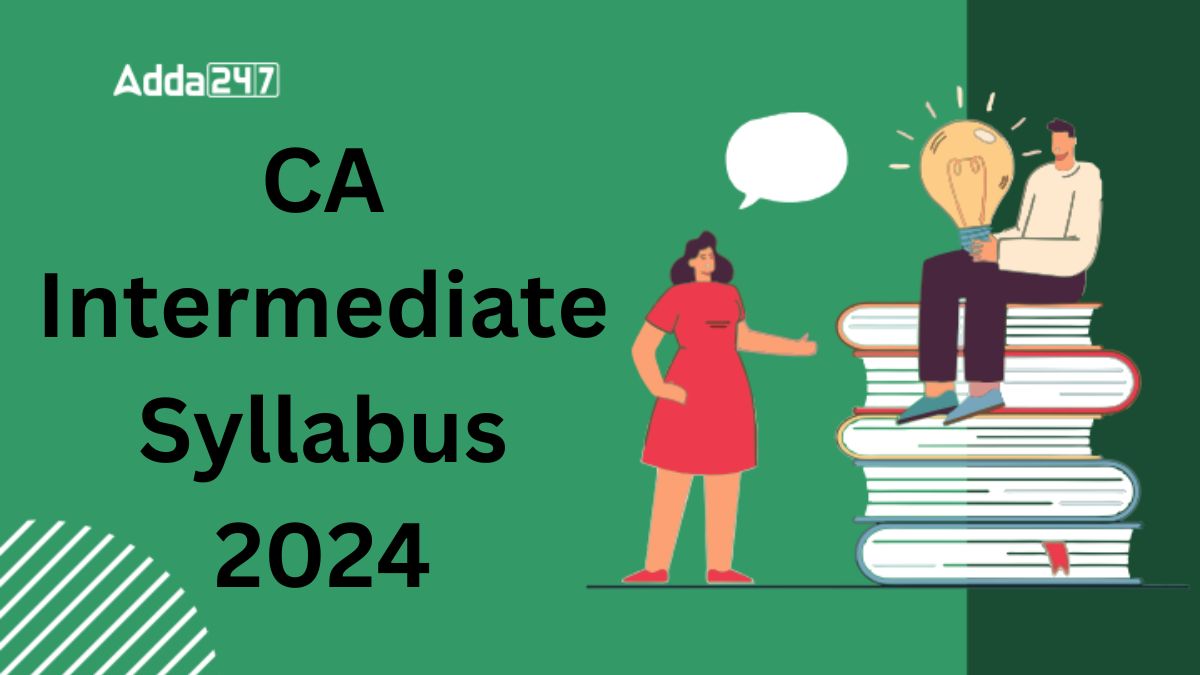The Institute of Chartered Accountants of India (ICAI) introduced a new CA Intermediate syllabus 2024 as part of an updated education and training scheme. This new CA Intermediate Syllabus 2024 will take effect from the May 2024 exam, marking a significant shift in the examination pattern and content. The CA Intermediate exam, which will now be held three times a year—January, May, and September—under the new scheme, will replace the previous syllabus that concluded with the November 2023 exam.
As this transition represents a major change for aspiring Chartered Accountants, it is crucial for candidates to thoroughly review the updated syllabus and adjust their study strategies accordingly to ensure they are well-prepared for the inaugural exam under the new framework.
CA Intermediate Syllabus 2024
The ICAI’s CA Intermediate New Syllabus 2024 brings several key updates aimed at aligning with contemporary accounting and auditing practices. This revised CA Intermediate Syllabus 2024, effective from the May 2024 exams, introduces a range of modern topics and advanced concepts, ensuring that the curriculum remains relevant to current industry standards. With an emphasis on recent developments in the field, the updated syllabus covers more sophisticated subject matter, reflecting the evolving landscape of accounting and finance. Below is a detailed table outlining the subjects and their respective marks under the new CA Intermediate syllabus for 2024.
CA Intermediate Exam Pattern 2024
The CA Intermediate Exam Pattern for 2024 introduces significant updates designed to enhance the relevance and rigor of the examination process. This revised pattern reflects the evolving demands of the accounting profession and aims to better assess the practical and theoretical knowledge of aspiring Chartered Accountants.
| CA Intermediate Exam Pattern for 2024 | ||
|---|---|---|
| S. No | Paper Name | Marks |
| 1 | Advanced Accounting | 100 Marks |
| 2 | Corporate And Other Laws | 100 Marks |
| – Part I: Company Law and Limited Liability Partnership Law | 70 Marks | |
| – Part II: Other Laws | 30 Marks | |
| 3 | Taxation | 100 Marks |
| – Section A: Income Tax Law | 50 Marks | |
| – Section B: Goods and Services Tax | 50 Marks | |
| 4 | Cost and Management Accounting | 100 Marks |
| 5 | Auditing and Ethics | 100 Marks |
| 6 | Financial Management and Strategic Management | 100 Marks |
| – Section A: Financial Management | 50 Marks | |
| – Section B: Strategic Management | 50 Marks | |
CA Intermediate Syllabus 2024 Detailed
The CA Intermediate Syllabus 2024 is structured into six main subjects, each with specific components. Here’s a simple breakdown to help students understand the updated CA Intermediate Syllabus 2024:
Advanced Accounting
In the CA Intermediate Syllabus 2024, Advanced Accounting is a key component that emphasizes practical application and detailed understanding of accounting principles. This section is designed to equip students with the skills necessary to handle complex accounting scenarios and prepare accurate financial statements. Key areas covered include:
| Topics | Sub Topics |
|---|---|
| Application of Accounting Standards | – AS1: Disclosure of Accounting Policies – AS2: Valuation of Inventories – AS3: Cash Flow Statements – AS4: Contingencies and Events Occurring After the Balance Sheet Date – AS5: Net Profit or Loss for the Period, Prior Period Items and Changes in Accounting Policies – AS6: Construction Contracts – AS7: Revenue Recognition – AS8: Property, Plant and Equipment – AS9: The Effects of Changes in Foreign Exchange Rates – AS10: Accounting for Government Grants – AS11: Accounting for Investments – AS12: Accounting for Amalgamations (excluding inter-company holdings) – AS13: Employee Benefits – AS14: Borrowing Costs – AS15: Segment Reporting – AS16: Related Party Disclosures – AS17: Leases Earnings Per Share – AS18: Consolidated Financial Statements of Single Subsidiaries (excluding problems involving acquisition of Interest in a Subsidiary at Different Dates, Cross holding, Disposal of a Subsidiary, and Foreign Subsidiaries) – AS19: Accounting for Taxes on Income – AS20: Accounting for Investment in Associates in Consolidated Financial Statements – AS21: Discontinuing Operations – AS22: Interim Financial Reporting – AS23: Intangible Assets – AS24: Financial Reporting of Interests in Joint Ventures – AS25: Impairment of Assets – AS26: Provisions, Contingent Liabilities, and Contingent Assets |
| Company Accounts | – Schedule III to the Companies Act, 2013 (Division I) – Preparation of Financial Statements: Statement of Profit and Loss, Balance Sheet, and Cash Flow Statement – Buyback of Securities – Accounting for the Reconstruction of Companies – Accounting for Branches, including Foreign Branches |
Corporate and Other Laws
| Topics | Sub Topics |
|---|---|
| Part 1: COMPANY LAW AND LIMITED LIABILITY PARTNERSHIP LAW | – The Companies Act 2013 – Preliminary Incorporation of the Company and Matters Incidental thereto – Prospectus and Allotment of Securities – Share Capital and Debentures – Acceptance of Deposits by Companies – Registration of Charges – Management and Administration – Declaration and Payment of Dividend – Accounts of Companies – Audit and Auditors – Companies Incorporated Outside India – The Limited Liability Partnership Act, 2008 including important Rules |
| Part 2: OTHER LAWS | – The General Clauses Act, 1897 – Important Definitions – Extent and Applicability – General Rules of Construction – Powers and Functionaries – Provisions as to Orders, Rules, etc. made under Enactments – Miscellaneous Provisions – Interpretation of Statutes – Rules of Interpretation of Statutes – Aids to Interpretation – Rules of Interpretation/Construction of Deeds and Documents – The Foreign Exchange Management Act, 1999 – Significant Definitions and Concepts of Current and Capital Account Transactions |
Taxation
The CA Intermediate Syllabus 2024 includes a comprehensive Taxation section aimed at equipping students with a deep understanding of both Income Tax and Goods and Services Tax (GST).
| Topics | Sub Topics |
|---|---|
| Section A: Income Tax Laws | – Basic Concepts – Introduction to Income-tax Law – Significant Concepts: Person, Assessee, Previous Year, Assessment Year, Income, Agricultural Income – Basis of Charge – Procedure for Computation of Total Income and Tax Payable for Individuals – Residential Status and Scope of Total Income – Determining Residential Status – Scope of Total Income – Heads of Income and Provisions for Computation – Salaries – Income from House Property – Profits and Gains of Business or Profession – Capital Gains – Income from Other Sources – Provisions Related to Income – Clubbing of Income – Set-off or Carry Forward and Set-off of Losses – Deductions from Gross Total Income – Advance Tax, TDS, and Tax Collection – Advance Tax – Tax Deduction at Source (TDS) – Tax Collection at Source (TCS) – Filing Return of Income and Self-Assessment – Provisions for Filing Returns – Self-Assessment – Alternative Tax Regimes – Computation of Total Income and Tax Payable under Alternative Tax Regimes to Optimize Tax Liability |
| Section B: Goods And Services Tax (GST) | – Objective – Understanding GST Law Provisions – Application in Moderate Complexity Scenarios – GST Laws: An Introduction – Constitutional Aspects – Levy and Collection of CGST and IGST – Application of CGST and IGST Law – Concept of Supply: Composite and Mixed Supplies – Charge of Tax including Reverse Charge – Exemption from Tax – Composition Levy – Basic Concepts – Classification – Place of Supply – Time of Supply – Value of Supply – Input Tax Credit – Computation of GST Liability – GST Liability Calculation – Compliance and Record Keeping – Registration – Tax Invoice, Credit and Debit Notes – Electronic Way Bill – Accounts and Records – Returns – Payment of Tax |
Cost and Management Accounting
In the CA Intermediate Syllabus 2024, Cost and Management Accounting focuses on understanding fundamental accounting concepts and their practical applications for cost calculation, pricing, planning, control, and decision-making.
| Topics | Sub Topics |
|---|---|
| Overview of Cost and Management Accounting | – Introduction to Cost and Management Accounting – Objectives and Scope – Users of Cost and Management Accounting Information – Functions of Management Accounting – Role of Cost Accounting Department – Installation of Costing System – Relationship with Financial Accounting, Management Accounting, and Financial Management – Cost Terms and Concepts – Cost Reduction and Cost Control |
| Elements of Costs | – Cost Behavior Pattern – Fixed, Variable, Semi-Variable, and Step Costs – Methods and Techniques of Costing – Digital Costing |
| Elements of Cost and Preparation of Cost Sheets | – Functional Classification and Ascertainment of Cost – Preparation of Cost Sheets for Manufacturing and Service Sectors |
| Ascertainment of Cost and Cost Accounting System | – Material Cost – Procurement Procedures – Valuation of Material – Stock Verification – Digital Costing and ERP – Tender and Quotation Process – Inventory Control – Techniques for Stock Levels: Minimum, Maximum, Reorder Point, Safety Stock – Optimum Order Quantity (EOQ) – Techniques: ABC Analysis, FSN, HML, VED, JIT – Stock Taking and Perpetual Inventory – Digital Inventory Control – Treatment of Normal/Abnormal Losses |
| Employee Cost | – Attendance and Payroll Procedures – Elements of Wages – Employee Cost Control – Employee Turnover – Remuneration Systems and Incentive Schemes |
| Direct Expenses | – Identification and Treatment of Direct Expenses |
| Overheads | – Functional Analysis – Factory, Administration, Selling, Distribution, Research and Development – Behavioral Analysis – Fixed, Variable, and Semi-Variable – Allocation and Apportionment – Factory Overheads: Primary and Secondary Distribution – Administration Overheads – Selling & Distribution Overheads – Treatment of R&D Costs – Activity-Based Costing (ABC) |
| Integration of Cost and Financial Data | – Recording and Segregation of Financial Data – Non-Integrated and Integrated Accounting Systems – Reconciliation of Profit (Cost vs. Financial Accounts) |
| Methods of Costing | – Single Output/Unit Costing – Job Costing – Job Cost Cards and Databases – Direct Costs and Overheads – Batch Costing – Optimum Batch Quantity – Batch Cost Sheet – Spoiled and Defective Work – Process/Operation Costing – Process Cost Recording – Process Loss, Abnormal Gains and Losses – Equivalent Units of Production – Inter-Process Profit – Joint Products and By-Products – Apportioning Joint Costs |
| Costing of Service Sectors | – Determination of Costs and Prices of Services |
| Cost Control and Analysis | – Standard Costing – Setting up Standards – Standard Costing for Performance Measurement – Reconciliation of Costs – Marginal Costing – Basic Concepts – Contribution Margin – Break-Even Analysis – Contribution to Sales Ratio – Margin of Safety – Cost-Volume-Profit Analysis (CVP) – Comparison with Absorption Costing – Short-Term Decision Making – Make or Buy Decision – Discontinuation Decision – Multiproduct Break-Even Analysis – Limiting Factor |
| Budget and Budgetary Control | – Meaning and Essentials of Budget – Budget Manual – Budget Setting Process – Preparation and Monitoring – Flexible Budgets – Functional Budgets – Cash Budget – Master Budget – Principal/Key Budget Factors – Zero-Based Budgeting (ZBB) – Performance Budget – Control Ratios – Budget Variances – Motivation and Budgeting – Feedback and Feedforward Controlling |
Auditing and Ethics
The CA Intermediate Syllabus 2024 for Auditing and Ethics is designed to provide students with a thorough understanding of auditing principles, techniques, and ethical standards. This syllabus covers the essential aspects of audit processes, from planning and risk assessment to audit evidence and documentation.
| Topics | Sub Topics |
|---|---|
| Nature, Objective, and Scope of Audit | – Auditing Concepts: – Origin of Auditing – Meaning and Need for Audit – Objectives and Scope of Audit – External Audit Engagements – Qualities of an Auditor – Inherent Limitations of an Audit – Relationship with Other Disciplines – (SA 200 Overall Objectives of the Independent Auditor and the Conduct of an Audit under Standards on Auditing) |
| Audit Strategy, Audit Planning, and Audit Program | – Responsibilities in Planning an Audit – Benefits of Audit Planning – Continual and Iterative Planning Process – Discussion with Management – Involvement of Key Team Members – Preliminary Engagement Activities – Client Continuance and Ethical Requirements – Establishing Overall Audit Strategy – Developing Audit Plan and Program – Documenting Strategy and Plan |
| Risk Assessment and Internal Control | – Audit Risk: – Risk of Material Misstatement – Inherent Risk, Control Risk, and Detection Risk – Sampling and Non-Sampling Risk – Concept of Materiality – Materiality in Planning and Performing Audit – Professional Judgment in Materiality – Performance Materiality – Documenting Materiality – (SA 320 Materiality in Planning and Performing an Audit) – Risk Assessment Procedures: – Identifying and Assessing Risks – Understanding Entity and Environment – Evaluating Internal Control System – Testing Internal Control – Internal Control and IT Environment – Digital Audit and Impact of IT Risks |
| Audit Evidence | – Meaning and Relevance: – Relevance and Reliability of Audit Evidence – Sufficient Appropriate Audit Evidence – Assertions in Financial Statements – Source of Audit Evidence – Test of Controls – Substantive Procedures: Test of Details and Analytical Procedures – Evaluation of Evidence – (SA 500 Audit Evidence) – Internal Audit Function: – External Auditor’s Responsibility – Evaluating Internal Audit Function – Basics of Internal Financial Control – Difference between Internal Financial Control and Internal Control over Financial Reporting – Audit Sampling: – Meaning and Types of Sampling – Designing and Selecting Sample – Sample Size and Selection Methods – External Confirmation Procedures – (SA 530 Audit Sampling) |
| Audit of Items of Financial Statements | – Audit Areas: – Sale of Products and Services – Interest, Rental, and Dividend Income – Purchases, Employee Benefits, Depreciation, etc. – Share Capital, Reserves, Liabilities – Land, Buildings, Plant, Equipment – Loans, Receivables, Inventories, Cash – Contingent Liabilities |
| Audit Documentation | – Concept and Purpose: – Nature, Form, and Content of Documentation – Completion Memorandum – Ownership and Custody – (SA 230 Audit Documentation) |
| Completion and Review | – Subsequent Events: – Auditors’ Obligations and Procedures – (SA 560 Subsequent Events) – Going Concern: – Responsibilities and Objectives – Events or Conditions Affecting Going Concern – (SA 570 Going Concern) – Evaluations of Misstatements: – (SA 450 Evaluation of Misstatements) – Written Representations: – Objective and Management Requests |
| Audit Report | – Forming an Opinion: – Auditor’s Report Elements – Communicating Key Audit Matters – Types of Modified Opinions – (SA 700, SA 701, SA 705, SA 706) – Comparative Information: – Nature and Reporting – (SA 710 Comparative Information) – Branch and Joint Audits: – Reporting Requirements – Special Features for Different Entities |
| Special Features of Audit | – Types of Entities: – Government, Local Bodies, Not-for-Profit Organizations – Partnership Firms, Educational Institutions, Hotels, Clubs, Hospitals – Limited Liability Partnerships (LLPs) and Co-operative Societies |
| Audit of Banks | – Understanding Accounting Systems: – Audit Approach – Revenue Items – Advances and NPAs |
| Ethics and Terms of Audit Engagements | – Ethics: – Meaning and Need for Professional Ethics – Principles vs. Rules-Based Approaches – Fundamental Principles: Integrity, Objectivity, Competence, Confidentiality, Behavior – Independence of Auditors – Threats and Safeguards – Terms of Audit Engagements: – Preconditions and Agreements – Recurring Audits – (SA 210 Agreeing the Terms of Audit Engagements) – Quality Control: – Overview of SQC 1 and SA 220 |
Financial Management and Strategic Management
The CA Intermediate Syllabus 2024 for Financial Management and Strategic Management equips students with essential skills for managing finances, making strategic decisions, and understanding the intricacies of financial and strategic planning.
| Section | Topics | Sub Topics |
|---|---|---|
| SECTION A: FINANCIAL MANAGEMENT | Financial Management and Financial Analysis | – Introduction to Financial Management Function – Objectives and Scope: Profit Maximisation, Wealth Maximisation, and Value Creation – Role of Financial Manager and Controller – Financial Environment – Functions of Finance Executives – Financial Distress and Insolvency – Financial Analysis through Ratios – Users and Sources of Financial Data – Calculation, Interpretation, and Limitations of Ratios |
| Financing Decisions and Cost of Capital | – Sources of Finance: – Long-term Debt and Equity – Short-term Finance – Contemporary and International Sources – Lease Financing, Convertible Debt, Venture Capital – Cost of Capital: – Significance and Measurement – Weighted Average Cost of Capital (WACC) – Marginal Cost of Capital |
|
| Capital Structure Decisions | – Significance and Determinants of Capital Structure – Capital Structure Planning – Theories of Capital Structure – EBIT-EPS Analysis, Breakeven EBIT Analysis – Under/Over Capitalisation – Leverages: Operating, Financial, Combined |
|
| Capital Investment and Dividend Decisions | – Capital Investment Decisions: – Methods of Investment Appraisal – Payback Period, Discounted Payback Period, ARR – NPV: Strengths, Limitations, Capital Rationing – IRR and MIRR – Profitability Index – Dividend Decisions: – Types of Dividends and Determinants – Dividend Policies: Traditional Approach, Walter’s Model, Gordon’s Model, MM Hypothesis |
|
| Management of Working Capital | – Liquidity vs. Profitability – Working Capital Financing Decisions – Working Capital Cycle – Management of Accounts Receivables and Payables – Credit Management – Cash Management and Treasury Management – Banking Norms of Working Capital Finance |
|
| SECTION B: STRATEGIC MANAGEMENT | Introduction to Strategic Management | – Meaning and Nature – Importance and Limitations – Strategic Intent: Vision, Mission, Goals, Values – Strategic Levels in Organizations (Network, Corporate, Business, Functional) |
| Strategic Analysis: External Environment | – International and Macro Environment: – PESTLE Analysis – Industry Analysis: Value Chain, PLC – Porter’s Five Forces – Understanding Customers and Markets – Industry Competition |
|
| Strategic Analysis: Internal Environment | – Key Stakeholders: – Mendelow’s Model – Strategic Drivers: Industry, Markets, Customers, Channels – Resources and Capabilities – SWOT Analysis – Competitive Advantage – Michael Porter’s Generic Strategies |
|
| Strategic Choices | – Strategic Options: – Concentric, Conglomerate, Market and Product Development, Innovation – Horizontal and Vertical Integration – Turnaround, Divestiture, Liquidation – Development Tools: – Ansoff’s Matrix – ADL Matrix – BCG Matrix – GE Matrix |
|
| Strategy Implementation and Evaluation | – Implementation: – Formulation vs. Implementation – Linkages and Issues – Digital Transformation – Organization Structure and Culture – Strategic Leadership – Strategic Control – Strategic Performance Measures |
| Check other related articles | |
| CA Foundation Syllabus 2024 | How to Start CA Preparation After Graduation |



 SSC GD Constable Apply Online 2026 Start...
SSC GD Constable Apply Online 2026 Start...
 AIIMS CRE Exam City Intimation 2025 Out,...
AIIMS CRE Exam City Intimation 2025 Out,...
 RRB NTPC CBT 2 Scorecard 2025 Out For Gr...
RRB NTPC CBT 2 Scorecard 2025 Out For Gr...
 Adda247 Job portal has complete information about all Sarkari Jobs and Naukri Alerts, its latest recruitment notifications, from all state and national level jobs and their updates.
Adda247 Job portal has complete information about all Sarkari Jobs and Naukri Alerts, its latest recruitment notifications, from all state and national level jobs and their updates.



